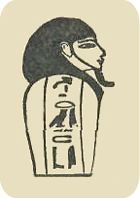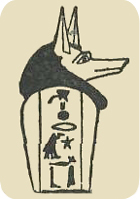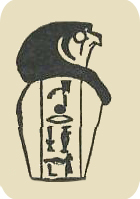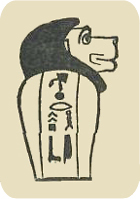Egyptian Gods: Four Sons of Horus
- Details
- Written by AndEl
Egyptian Gods: Four Sons of Horus
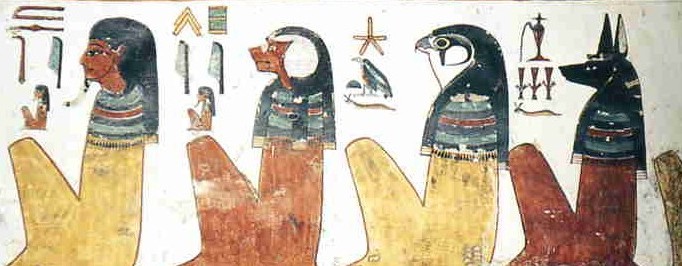
The four sons of Horus (from left): Imsety, Hapi, Qebehsenuef, Duamutef
The four sons of Horus were a group of four gods in Egyptian religion, who were essentially the personifications of the four canopic jars, which accompanied mummified bodies. Since the heart was thought to embody the soul, it was left inside the body. The brain was thought only to be the origin of mucus, so it was reduced to liquid, syphoned off, and discarded. This left the stomach (and small intestines), liver, large intestines, and lungs, which were removed, embalmed and stored, each organ in its own jar. There were times when embalmers deviated from this scheme: during the 21st Dynasty they embalmed and wrapped the viscera and returned them to the body, while the Canopic jars remained empty symbols.
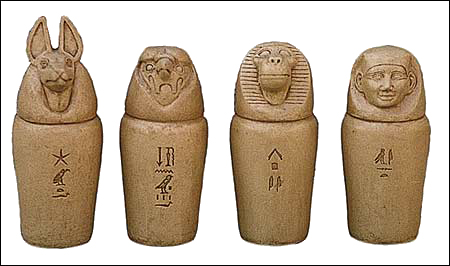
The earliest reference to the sons of Horus is found in the Pyramid Texts where they are described as friends of the king, as they assist the king in his ascension to heaven in the eastern sky by means of ladders. Their association with Horus specifically goes back to the Old Kingdom when they were said not only to be his children but also his souls. As the king, or Pharaoh was seen as a manifestation of, or especially protected by, Horus, these parts of the deceased pharaoh, referred to as the Osiris, were seen as parts of Horus, or rather, his children, an association which did not diminish with each successive pharaoh. Since Horus was their father, so Isis, Horus’ original wife (i.e. his wife in early mythologies), was usually seen as their mother, though in the details of the funerary ritual each son, and therefore each canopic jar, was protected by a particular goddess. Just as the sons of Horus protected the contents of a canopic jar, the king’s organs, so they in turn were protected. As they were male in accordance with the principles of male/female duality their protectors were female.
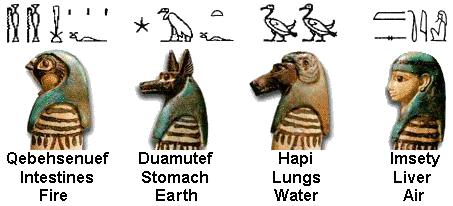
Imsety in human form, protected the liver and was protected by Isis. Hapi in baboon form, protected the lungs and was protected by Nephthys. Duamutef in jackal form, protected the stomach and was protected by Neith. Qebehsenuef in hawk form, protected the large intestines and was protected by Serket.
The classic depiction of the four sons of Horus on Middle Kingdom coffins show Imsety and Duamutef on the eastern side of the coffin and Hapi and Qebehsenuef on the western side. Because the eastern side is decorated with a pair of eyes and the mummy was turned on its side to face the east and the rising sun, this side is sometimes referred to as the front. The sons of Horus also became associated with the cardinal compass points, so that Hapi was the North, Imsety the south, Duamutef the east and Qebehsenuef the west.
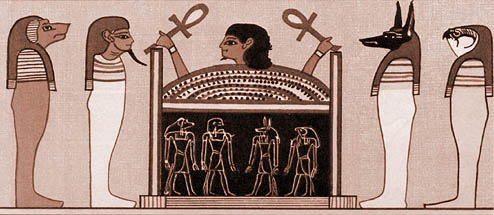
Up until the end of the 18th Dynasty the canopic jars had the head of the king but later they were shown with animal heads. Inscriptions on coffins and sarcophagi from earliest times showed them usually in animal form.
Hapi
Hapi is one of the Four sons of Horus in ancient Egyptian religion, depicted in funerary literature as protecting the throne of Osiris in the Underworld. He is commonly depicted with the head of a hamadryas baboon, and is tasked with protecting the lungs of the deceased, hence the common depiction of a hamadryas baboon head sculpted as the lid of the canopic jar that held the lungs. Hapi is in turn protected by the goddess Nephthys. When his image appears on the side of a coffin, he is usually aligned with the side intended to face north. When embalming practices changed during the Third Intermediate Period and the mummified organs were placed back inside the body, an amulet of Hapi would be included in the body cavity.
The spelling of his name includes a hieroglyph which is thought to be connected with steering a boat, although its exact nature is not known. For this reason he was sometimes connected with navigation, although early references call him the great runner.
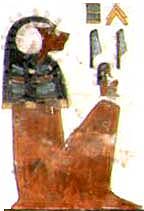
Imseti
In Egyptian mythology, Imseti (also transcribed Imset, Amset, sety, Mesti, and Mesta) was a funerary deity, who were associated with the canopic jars, specifically the one which contained the liver. Unlike his brothers, Imsety was not associated with any animal and was always depicted as human. The early form of Isis was considered his protector. His Canopic Jar guards the liver.
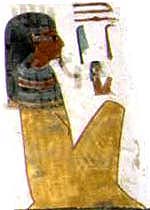
Duamutef
Duamutef was one of the Four Sons of Horus and a protection god of the Canopic jars. Commonly he is said to be the son of the god Horus the Elder (Heru-ur) and the goddess Isis. There is another myth that describes Duamutef and his brothers as sons of Osiris. According to this myth they were born from a lotus blossom that arose from the primeval ocean.
The name Duamutef means “Who adores his mother”.
First Duamutef was displayed as human wrapped in mummy bandages. Since the New Kingdom he is shown with the head of a jackal. In some cases his appearance is swapped with Qebehsenuef’s so he has the head of a falcon and Qebehsenuef has the head of a jackal.
Duamutef usually was shown on Sarcophagus and as cap of canopic jars. Some images of the Judgement of heart show him staying together with his brothers in front of Osiris on a small lotus blossom.
Together with the three other sons of Horus Imsety, Hapi and Qebehsenuef he protected the mummified internal organs. His duty was to protect the stomach.
The Pyramid texts name Duamutef as protection god of the deceased and their helper for the advance to heaven. The inscriptions of canopic jars and canpic chests he is called to protect from hunger and thirst.
According to the Egyptian Mythology he and his brothers where dedicated as protectors of the cardinal directions of the sky. Duamutef was dedicated to the east and he was also one of the star gods. For this reason Duamutef appears on astronomical documents to describe the direction where stars are placed.
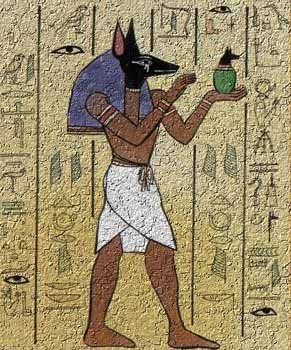
Qebehsenuef
Qebehsenuef also spelled and variously transliterate as Kebehsennuf, Kebechsenef, Qebshenuf, Qebehsenuf or Kabexnuf. It means (‘He who refreshes his brothers’) was one of the sons of Horus in Egyptian mythology, the god of protection and of the West. In the preparation of mummies, his canopic jar was used for the intestines. He is seen as a mummy with a falcon head. He was said to be protected by the goddess Serket.
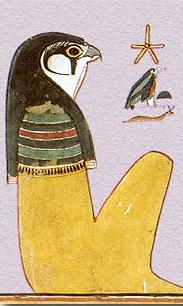
Source Here
Autopsy – Dissecting the Names of the Four Sons
In addition to consulting some of the oldest recordings of the religion such as the Pyramid Texts from the 5th and 6th Dynasties, we can analyze the way their names are written to give us a better understanding of their meaning and significance.
Let’s break down their names one at a time:

Duamutef
The name is built from the source word for ‘adoration’, ‘morning’, or ‘hyms’. The next word ‘mut’ in the form of the vulture means ‘mother’ and the ‘ef’ on the end signifies ownership, specifically male ownership and so can be translated as ‘his’.

Qebehsenuef
This word is formed by the combination of two words qebeh, meaning ‘libation’, ‘cool water’, or ‘refreshing liquid’ and the word senu, meaning ‘brothers’, ‘companions’, ‘flagstaffs’. Once again the additional ‘ef’ on the end of the word adds the word ‘his’.

Hapy
Hapy is the god of the Nile and some of the dictionary entries for words of the same ilk are ‘to ride in a boat’, ‘oarsman’, ‘oar’ and ‘hand’.

Imsety
Imsety stems from the same root as words like ‘bring’, ‘liver’, ‘goose’, ‘staff or rod (of Osiris)’, ‘present’, ‘offer’.
Very broadly speaking then, we can understand the meaning of the Four Sons of Horus as:
“Morning, mother, cool water, brothers, Nile, ride in a boat, bring the staff of Osiris.”
The Cool Brothers of the Staffs Bring the Boat in the Morning
The ancient texts, when referring to the Four Sons of Horus, do feature most of these aspects in their functions. The Pyramid Texts speak of them as ferrying the king over to the eastern horizon in a boat in the morning.
‘Let me fetch for the King this boat of yours in which your pure ones are ferried across in order to obtain for you the cold water at the (polar) quarter of the Imperishables Stars’…
…they go to these four youths who stand on the east side of the sky. They bind together for Re the two reed-floats on which Re goes to his horizon; they bind together for me the two reed-floats on which I go to the horizon of Re.
- Pyramid Texts Utterance 519.
O Hapy, Imsety, Duamutef, Kebhsenuf, bring me this boat which Khnum built, which is in this waterway of the Htm-bird.
- Pyramid Texts Utterance 522
Utterance 263 says:
They bring to me these four spirits, the Elders who are at the head of the wearers of the side-lock, who stand at the eastern side of the sky and who lean on their staffs, that they may tell my good name to Re….I am ferried over to the eastern side of the sky and my sister is Sothis, my offspring is the dawn light.”
- Pyramid Texts Utterance 263.
The expression ‘wearers of the side-lock’ is reference to their youthfulness, children are always represented wearing a side-lock of hair. This sentiment is repeated in utterances 264, 265, 266.
In utterance 505 the Four Sons of Horus are again referred to as helping ferry the king across the night sky to the eastern horizon:
Ferry me over and put me down at the Field of Rushes, these four spirits who are with me are Hapy, Duamutef, Imsety, and Kebhsenuf, two on one side and two on the other.
- Pyramid Texts Utterance 505
The Four Sons of Horus are also responsible for providing food & water to the King:
Hapy, Duamutef, Kebhsenuf, and Imsety will expel this hunger which is in my belly and this thirst which is on my lips.
- Pyramid Texts Utterance 338
In Utterance 506 the King claims he is himself the four sons of Horus:
I am a she-jackal, I am jackal-like; I am Hapy; I am Duamutef; I am Imsety, I am Khebhsenuf;…
- Pyramid Texts Utterance 506
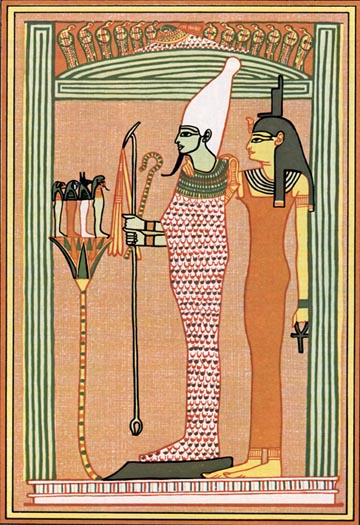
The Four Sons of Horus combined on top of a lotus flower from the papyrus of Ani
Imsety |
Duamutef |
Qebehsenuef |
Hapy |
|
|
|
|
|
Human-headed |
Jackal-headed |
Hawk-headed |
Baboon-headed |
Liver |
Stomach |
Intestines |
Lungs |
Isis |
Neith |
Selkhet |
Nepthys |
South |
East |
West |
North |
Four Supports & Stairway to Heaven
Heaven is described in the Pyramid Texts as resting on the staffs of these four gods (uttterance 556) who themselves are seen as personifications of these four points:
I have summond them, and these four gods who stand at the staffs of the sky bring them to me that they may tell my name to Re…
- Pyramid Texts Utterance 264.
Oh you four gods who stand at the supports of the sky…
- Pyramid Texts Utterance 556
Most often, however, the Four Sons of Horus are spoken of as appearing together in the east to help the King in his ascent into the sky:
|
These four gods, friends of the King, attend on this King, (namely) Imsety, Hapy, Duamutef, and Kebsenuf, the children of Horus of Khem; they tie the rope-ladder for this King, they make firm the wooden ladder for this King, they cause the King to mount up to Khoprer when he comes into being in the eastern side of the sky - Pyramid Texts Utterance 688. |
Utterances 544, 545, speak of the Four Sons of Horus lifting up the king:
O Children of Horus, Hapy, Duamutef, Imsety, Kebhsenuf, lift up your father this Osiris the King and guide him. O Osiris the King, it is caused that you be restored and that your mouth be split open, so stand up!
- Pyramid Texts Utterance 545
Four Northern Stars
In the New Kingdom the Four Sons of Horus became members of the ‘seven blessed ones’ who are in the northern sky and guard the coffin of Osiris.
“Imsety, Hapy, Duamutef, and Qebehsenuef, it is these who are behind the’ Constellation of the Thigh’ in the northern sky.”
- Papyrus of Ani, chapter 17, plate 9.
The Ancient Egyptian word for ‘Thigh’ is Khepesh and is the word used to denote the collection of stars commonly known today as the ‘Big Dipper’. They form the constellation of Ursa Major, which closely circles the north celestial pole, the region of the sky targeted by the descending passage of most Old Kingdom pyramids. These stars are also known as the “Imperishables”.
O King, Horus comes to you provided with his souls namely Hapy, Duamutef, Imsety, Kebhsenuf; they bring to you this name of yours of ‘Imperishable Star’, and you will never be perished nor be destroyed.
- Pyramid Texts Utterance 690.
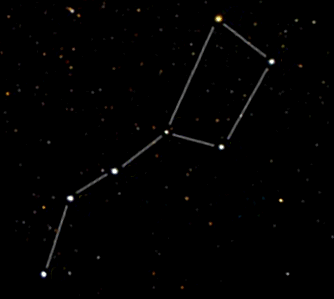
The 'Thigh' at the northern celestial polar region of the sky
This connection of the Four Sons of Horus with the constellation Ursa Major has been discussed by Egyptologist John Gee. His entire masters thesis was on the Four Sons of Horus, in which he noted that they were originally equated with the four stars that form the ‘bowl’ of the Big Dipper.
Bernard Mathieu confirmed the same in his paper ‘Theology and Astronomy Investigations in the Pyramid Texts’.
The celestial Four Sons of Horus could, then, be viewed as cranking the wheel of the cosmos, which is centered on the north celestial pole, the focus of the pyramid’s entrance.
This clockwork-like mechanism would provide the Sun, and therefore the dead King, with the force that will lift him up to be reborn in the eastern horizon after having descended into the depths of the Duat.
In Utterance 215 the Four Sons of Horus are said to be the King’s hands and feet and that they help him to ascend and descend in the sky:
Your hands are Hapy and Duamutef – you demand that you ascend to the sky and you shall ascend -
Your feet are Imsety and Kebhsenuf – You demand that you descend to the Lower Sky and you shall descend.
- Pyramid Text Utterance 215
So we can see from this brief look at the Pyramid Texts and the hieroglyphic construction of thier names that the function of the Four Sons of Horus is much more complex than being mere containers of the King’s organs. They work as a team each bringing some unique aspect to the task of restoring life to the King.
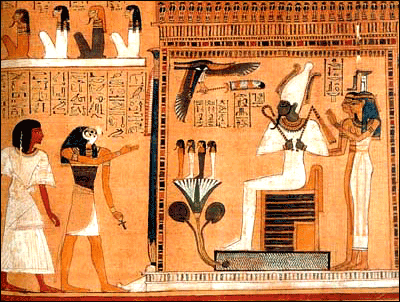
Source Here
Liked this article? Dive deeper into personal growth and wellness! Check out CrystalWind.ca for spiritual wisdom or explore AromaWorx.ca for natural well-being tips. Spread the positivity—share this with friends on their happiness journey!
Let’s Chat! Drop Your Thoughts Below! ![]()
Latest Articles
Dive into the Mystical World of the Crystal Wind Oracle Deck!
Get All the Enchanting Details Now!
NEW Expanded Boxed Edition!
Now with 58 Cards for Richer Wisdom!

Imagine a world of inspiration and healing, free for all—made possible by YOU!
Donate Now—Ignite the Magic at CrystalWind.ca!

Epilepsy - Finding A Cure
Your donation can make a difference!
Help us find a cure – donate now!
Unlock Your Light: Join Lightworkers Worldwide on CrystalWind.ca!
Articles: Hindu Mythology
Articles: Egyptian Mythology
Articles: Compendium
Follow Us!
Featured This Month
Lugh - Celtic God Of The Sun
The god Lugh was worshiped in Ireland as a deity of the sun. This connection... Read more
Lughnasadh (Lammas) - The Celtic Harvest Fes…
The Celtic harvest festival on August 1st takes its name from the Irish god ... Read more
Lammas by The Hedgewitch
Although in the heat of a Mid-western summer it might be difficult to discer... Read more
Lughnasadh Meditation
The Seventh Sabbat of the Wheel is Lughnasadh. Lughnasadh is celebrated on A... Read more
The Season of Lammas
The season of Lammas (also called Lughnasadh) begins on August 1st and conti... Read more

